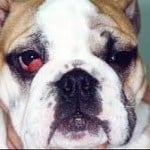Dog Cherry Eye is defined as a prolapse of the gland of the third eyelid. The medical term is “glandular hypertrophy.” Dry Eye describes changes that occur in the eye resulting from a lack of tears. Vets call this “KCS” which stands for Keratoconjunctivitis Sicca. Both conditions are fairly common in dogs. In addition, to the upper and lower eyelids, dogs and cats have a third eyelid that originates from the inside corner of the eye, the area closest to the nose. This third eyelid, acts like a windshield wiper and helps protect the eye. In addition, it contains a gland called the Nictitans, that produces 30 to 60 percent of the tear film. The tears keep the clear front part of the eye called the cornea lubricated. Cherry Eye is the term used when this gland prolapses or pops out from the third eyelid.
Causes of Dog Cherry Eye
The exact cause of Dog Cherry Eye is somewhat controversial. Some experts believe it is a genetic condition because cocker spaniels, beagles, bulldogs, and Pekingese seem to be predisposed. But other breeds including bloodhounds, great Danes and basset hounds are also commonly affected. Whether or not trauma is also a cause is still a matter of debate between veterinary eye specialists.
In dogs with Cherry Eye the prolapsed gland is red and fleshy. It looks like a small cherry that suddenly pops up and protrudes from the inner corner of the eye. If one eye is affected, the other eye may or may not also be affected at a later date. Dogs with Cherry Eye are usually less than a year old. In addition to the redness and swelling, a clear or mucus discharge may also occur.
Treatment for Dog Cherry Eye
The best treatment for Dog Cherry Eye is to surgically replace the gland back inside the third eyelid. That way the gland continues to produce ‘tears” and the risk of Dry Eye and corneal ulceration are prevented. When performed by an eye specialist also referred to as a Board Certified Veterinary Ophthalmologist, the prognosis for cases treated by replacing this gland is guarded as up to 50 percent of these cases still fail.
Past treatments included surgical removal of the gland, this often lead to a lack of tear film production which resulted in Dry Eye. Ignoring the Cherry Eye is another option. Sometimes it goes away on its own in two to three weeks, other times it leads to further eye disease. The owner and vet need to discuss treatment options, which will vary depending on the breed, financial considerations, and the owner’s personal wishes.
Complementary Therapy for Dog Cherry Eye
Lubricating the Cherry eye and keeping the eye moist is critical to prevent corneal ulcer formation. Sterilized, Norwegian Virgin Cod Liver Oil is excellent to lubricate the eye and once well lubricated pet owners may ask their veterinarian to show them how to manually replace the Cherry Eye.
This may be an effective alternative in certain cases.
